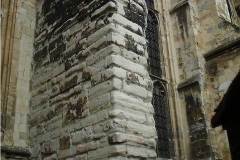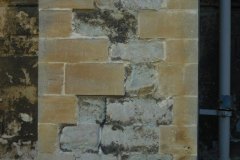Basics
Geology: sandy limestone
Rock unit: Hythe Formation, Lower Greensand
Age: Lower Cretaceous
Provenance: Hythe & Maidstone districts
Where to see examples
in south-facing buttresses of the cathedral nave (see images further below)
beyond the cathedral – see Westgate for accessible example of Kentish Ragstone
Description
Building stone taken from the Hythe Formation for building purposes is better known as Kentish Rag or Kentish Ragstone. The rock unit, from which the beds are quarried, was deposited in a warm shallow sea close to land. The stone is a greensand and contains small grains of the green iron mineral glauconite along with numerous sand grains and varying quantities of fossil material. These constituents are all bound by a carbonate cement. This sandy limestone (in places a calcareous sandstone) has been quarried since Roman times.
The word ‘rag’ is said to take its name from the ragged way in which the stone breaks. Not surprisingly the stone is often roughly dressed in buildings and its main use has been for the construction of rubble walls. The south facing buttresses of the cathedral nave show a roughly dressed stone. However, some beds will take a sharp edge and ashlar blocks and finely sculpted dressed stone can be found in many buildings.
Much of Maidstone has been built from Kentish Rag and many medieval and Victorian churches in Kent provide excellent examples of its use. The main centre of quarrying was in and around Maidstone and much stone was exported by boat down the River Medway to ports in Kent and up the River Thames to London. Coastal quarries at Hythe also produced Kentish Ragstone. Most stone bound for medieval Canterbury was shipped to Fordwich via the Wantsum Channel.
At the time of writing (November 2017) there is only Hermitage Quarry, near Madistone, extracting Kentish Ragstone. It is described as a highly durable material and much of the stone from the quarry is used for aggregate. However, stone suitable for both rubble and ashlar walling is also available; some is utilised for new constructions and the remainder for restoration projects.
Click on the images below to enlarge


